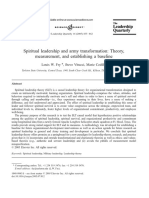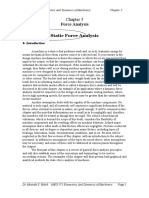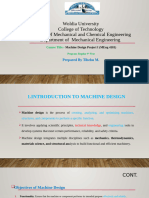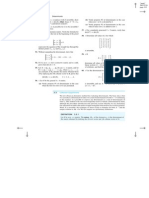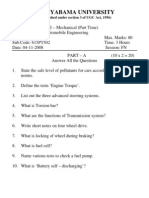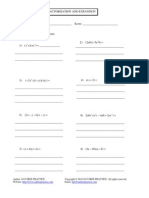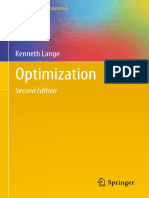Synthesis, Analysis and Simulation of A Four-Bar Mechanism Using Matlab Programming
Uploaded by
PedroAugustoSynthesis, Analysis and Simulation of A Four-Bar Mechanism Using Matlab Programming
Uploaded by
PedroAugustoSYNTHESIS, ANALYSIS AND SIMULATION OF A FOUR-BAR MECHANISM
USING MA TLAB PROGRAMMING
Mekonnen Gebreslasie and Alem Bazezew
Department of Mechanical Engineering
Addis Ababa University
ABSTRACT
Tracer
The four-bar mechanism is a class of mechanical Point
linkage in which four links are pinned together to .
form a closed loop in order to perform some useful
motion. This has long been, and continues to be, an " "" TracerPointCurve
.
"-
"-
effective toolfor mechanical design engineers. This "-
'-
"-
paper considers synthesis, analysis and simulation '-
of the four-bar linkage analytically for three and
four precision positions of the motion generation
problem. Kinematic synthesis of the four-bar
mechanism using the complex number method is
presented. The results of the synthesis process are III/I///.
analyzed to determine ftlotion characteristics of the Ground
mechanism. These motion characteristics are then
/:
used for simulation of the mechanism. Matlab Ground
programs are written for solving the equations
developed in the synthesis and analysis problems.
Matlab 'is also used to develop user-friendly
Graphic User Interface windows for data input and Figure I F<?ur-barmechanism
output as well asfor simulation.
will pass. The orientation of the coupler link is not
INTRODUCTION important, but the times at which the tracer point
passes the prescribed locations may be important.
Mechanism synthesis is the process of generating In this case the synthesis problem is path
the geometry of a mechanism that will perform a generation with prescribed timing. The film
specific task. Inhere, geometry generation means advancing mechanism in a movie camera is an
determining the lengths of the individual links that application of path generation.
make up the mechanism for performing a desired
task. In this paper the focus will be on the planar' Motion Generation (Rigid-body Guidance) defines
four bar mechanism as shown in Fig. I. locations through which the tracer point passes and
the corresponding orientation of the coupler link at
There are three broad categories that are considered those rocations. Examples of motion generation
in the synthesis process. These are outlined below. include the power lift, gate on a truck, the lift
mechanism on a dumpster truck, and the
Function Generation defines the relationship windshield wipers on an automobile.
between the position of the output link and the
position of the input link. The motion that the For all three synthesis types the prescribed
coupler link goes through is not of concern. conditions. that the mechanism must satisfy are
Example~ of function generation include the called the precision positions. For function
automobile accelerator, the control stick in an generation the precision positions consist of the
aircraft, and the piston in an engine mechanism. pairs of input and output angles, Pi and Yi
respectively, that the mechanism must meet. For
Path Generation defines locations through which a path generation the precision positions are the pairs
tracer point, or a point of interest, on the coupler of coordinates (Xi, Yi) which the tracer point must
pass through. In addition, for prescribed timing the
JpurnalofEAEA, Vol. 18,2001
86 Mekonnen Gebres/asie and A/em Bazezew
angle of the input (OJ will also be specified. In the ideal desired motion. But the problem becomes
case of motion generation the precision positions more difficult to solve as the number of precision
are the coordinates the tracer point passes through positions is increased. Fortunately, many real world
(x&Yj ), as well as the orientation' of the coupler problems only need several critical positions to be
defined by angle OJ. This paper deals with Motion satisfied precisely. Tolerance is usually allowed at
Generation problem of kinematic synthesis of a positions other than the precision points [6]. A four
four-bar mechanism. The synthesized mechanism bar linkage can satisfy up to five prescribed
is then analyzed .for determining its motion positions for the standard-form solutions of motion
characteristics. These results are then used for the generation problem [5].
animation of the mechanism.
The analytic synthe~is procedure ill algebraic and is
Conventional mechanism design procedures using less intuitive; hence, quite. suitable _ for
card board models, prototypes of the mechanism, computerization. In order to obtain a handle on the
making trial and error calculations, and a design variables and free choices, an analytical
combination of the above, have recently been model of the linkage must be developed: Several
getting replaced with the use of computer software. mathematical teqhniques for modeling linkages
Software packages can assist' the designer in have been utilized for planar synthesis objectives.
performing repetitive and programmable These include algebraic methods, matrix methods,
calculations fast and thus help in minimizing the and complex numbers. For planar linkages, the
errors that can be induced by human fatigue . . complex numbers technique is the simplest, yet the
most versatile method [5]. This technique uses
Various means of designing or synthesizing a . vectors to designate each of the links in the
mechanism to produce' desired motion in a four-bar, . mechanism. Fig. 2 shows the schematic
mechanism have been developed. Sandor and representation of the four-bar mechanism shown in
Erdman (1984) describe a method of solving the Fig. I by replacing the links by vectors [4].
problem~ using graphical constructions. They also
provide analytical equations to solve the same
problem computationally. Nikravesh 1988; Haug
1989; Shabana 1994, proposed methods bast<d on
the well-established absolute coordinate method for
kinematic analysis [3 },
Indeed, there are a number of tools like KYNSYN,
Watt, LINCAG~S [I] available, which are
commercially very expensive, that can be lised iIi
the analysis and synthesis of planar mechanisms.
Howeve'r, in this work, Matlab programming
language has been used as the graphic interface,
which is more user friendly and has also built in
routines that ease the programming difficulties.
FigUre') Schematis representation of the four-bar
Synthesis of the four-bar mechanism mech<i'1ism
In dimensional synthesis, • the component Loop Equations
dimensions that comprise a chosen mechanisma~e
specified to allow the mechanism' to perform a The equations and process for synthesizing the
given task [5]. four-bar mechanism are developed by introducing
dyads. The mechanism can be oroken in to two
Motion of the coupler can only be approximated by. dyads, WI and ZI which make up the input dyad,
several discrete precision points. That is, the and UI and SI which make up the output dyad.
resulting linkage can create the motion desired Specifying these two dyads is enough to determine'
precisely at these positions and approximately at the entire mechanism because .the remaining
other positions. The more precision points are used, vectors VI and GI can be derived from: .
the closer is the actual motion of the coupler to the VI=Zl~SJ
JournalofEAEA, Vol. 18, 2001
Synthesis, Analysis and Simulation of a Four-Bar Mechanism 87
W / (e iP, - i )+ Z / (e ia, - 1) = P /1
(1) (4)
W,(eiP;_l)+Z,(eia, -1)= PlJ
The angles between VI and Z], ZI and S], VI and SI
are fixed, as these vectors make up the rigid Equations (4) are commonly referred to as the
coupler link. known as a terinary link. Fig. 3 shows standard form loop equations, and each of them
the linkage in three successive positions. contains two scalar equations. Resolving the
vectors into real and imaginary parts, we have the
The equations that are used to generate solutions real parts as: '
for the input and output dyads are called loop
equations. The first loop begins at the ground pivot WCOSB(COSfJ2 -1) - wsinBsinfJ2 +
and proceeds out alorrg the second position dyad
vectors, .Wz and Zz. along the displacement vector , z cos¢(cosa2 -1) - z sin¢ sina2 = Pl2 cosc52
from the first precision point, PI. to the second ,(5)
precision point, P2, and then back along the first wco~cosA -l)-wsinBsinA +
position dyad vectors, ZI and WI, tl'J the ground
pivot. zcos¢(co923 -1) - zsin¢sinll:J= P13 cosO)
and the imaginary ones as:
wsi~co~ -l)-wcos9sin~ +zsin¢(co~ -1)-
zcogpsi~ = P12 sinc52
(6)
wsin e(cos fJ3 -1)- wcos e sin fJ3 + isin ¢(cos a3 -1)-
z cos ¢ sin a3 = P13 sin 03
In these equations there are twelve variables.
Namely, w, 0, P;b PJ, z, 1jJ, a;b aJ,PI], PJ3. 02 and
OJ. Six of these (a;b aJ, PI]. PJ3, 02 and oJ) are input
variables and since we have onry four equations we
can s91ve for only four of the remaining six
Figure 3 unknowns. The other two unknowns are taken as
free choices [5]. Taking Doand Doas the 'free
For the input and output dyads, the loop equations choices, as it is commonly done, the transcendental
become: non-linear equations are linearized.
"
. W1 + Z 1 - P/1 - Z / - W/ = 0 Equation (4) can be written in matrix form as:
(2)
WJ + Z J - PlJ - Z / - W / = 0 (7)
ea,
ea, -- j1Jl{W
Z //} PlJ }
= {P/1
Moving the displacement vector to the right hand
side and, using the relationship between the second Equation (7) is solved for WI and ZI, using the
position and first position vectors Cramer's rule. Taking P2 and PJ as free choices,
ea) - ea,
1 (8)
- 1
W / e iP, + Z / e ia, - Z / - W / = P lJ
(3)
W, =
e p, -
PlJ
1
ea, -l
IP /1e a, '--; 11
Ie P, - 1
And these equations can be simplified to:
Journal of EAEA, Vol. 18,2001
88 Mekonnen Gebreslasie a~d Alem Bazezew
(14)
z, lefJ'-1
eP' -I PIJ I
Po (9) eifJJ
eiP•
-
-
1
II
[el/l' -
eP'-1
!efJ'-1 eaJ_I
ea'_I!
In this case, the resulting six scalar equations have
seven unknowns and can not be ·solved unless one
Similarly, from the right hand dyad, UI and SI are of the unknowns is taken as a free choice. Although
obtained from: one of the unknowns is made a free choice, the
system of equations, unlike to that for three
(10) positions, is still non-linear. Rearranging the
[ee'lr, -- I ea,
ea, -- II]{US II} PIJ
= {Po} equations yields,
Equatio~ 00) can be solved for U/ and S], taking (15 )
Y2 and YJ as free choices.
(11 )
IPo ea, - II From Eq. (15) it can be noted that, because of the -
er'-I eaJ_I 1 term, the vector can never be equal to zero.
Therefore, .the matrix must be singular or non-
u, = 1':'''-1 '::,- ~ 11 invertible. Hence, the determinant of that matrix
equals zero. i.e.,
and PIJ - (12)
eaJ I
ee'lr, -- I I eiP, -] eia,
eiaJ1=-] 0
Pu
PJ]
PlJ
ea,
Po - I II
let' - I (16)
lerl - I eifJJ
eifJ, -]
Expanding the determinant yields
Wb Zb' U/ and S/ are complex numbers
representing the links of the four bar linkage. The aeifJ, +beifJl +ceifJ, -(a+b+c)=O (17)
remaining vectors V/ and G/ are obtained from ijq.
(1) .
. where.
The lengths of the links are expressed by the
a = (eia, -1)Pu - (eia• -1)PIJ
magnitudes of the corresponding vectors.
Designating the lengths of the ground link by "1, b = (eia• -1)PI2 - (eia, - I)PI4
the input crank link by r], the coupler link by rJ and c = (eia, -1)P13 - (eia) -l)Pl1
output link by r4, we have,
Taking one of the three unknowns in Eq. (17) as
the free choice, it is possible to solve for the other
two unknowns using the Symbolic Math Toolbox
Synthesis of Four-bar mechanisms for Four of Matlab. If we make /32 the free ch,oice we can
positions solve for /33 and /34. Now, the problem is reduced to
the linear system of equations given by Eq. (18)
In _a manner similar to the synthesis of four-bar which can be solved for the remaining unknowns
mechanisms for three positions, the following WI and ZI using Cramer's rule.
equations can be developed considering four
positions for the left hand dyad.
( 18)
JournalofEAEA, Vol. 18,2001
Synthesis, Analysis and Simulation of a Four-Bar Mechanism 89
Analysis of the four-bar mechanism coordinates. To solve the system of nonlinear
equations given by Eq. (19), it is customary to
To carry out the analysis of the four-bar resort to the well-known Newton-Raphson method
mechanism, the equations that define the relative which has quadratic convergence in the
movement of the links are derived using the neighborhood of the solution.
physical dimensions obtained from the synthesis.
The configuration of the linkage depends on a free The Newton-Raphson method is based' on
parameter, which is typically the rotation angle of linearizing the system of Eqs. (19) in which the
one link, known as the driving link. system of equations is replaced by the first tWo..
terms of its Taylor series expansion around a
In this paper we are concerned with' those certain approximation lO) of "the desired solution.
mechanisms that generate closed coupler curves for Once the substitution has been made, the system
a complete crank rotation. Such mechanisms are becomes
called GrashofMechanisms.
The GrashoFs Criterion
Grashofs criterion states that the sum of the where matrix l/J q is the Jacobian matrix for the
shortest and longest links of a planar four-bar
linkage 'can not be greater than the sum of the constraint equations.l/J q is the matrix of partial
remaining two links, if there is to be continuous derivatives of the constraint equations with respect
relative rotation between two lin~ [5]. to the dependent coordinates where m is the
number of constraint equations and n is the number
If this rule is satisfied, in other words, if of dependent coordinates.
l+s<p+q,
Equation (20) represents a system of linear
where I and s are the longest and shortest links of
equations constituting an approximation to the non-
the four-bar mechanism, we may have a crank-
linear system of Eq. (19). The vector q(l), obtained
rocker, a double-crank, or a double-rocker
from the solution of Eq. (20), will be an
depending on the position and configuration of the
links. approximation of the solution of Eq. (19). Going
through this process repeatedly, the following
recursive formula is developed.
Position Analysis
The position problem basically consists of
determining the position of all the links in the
system given the positions of the fixed and the Equation (20) is solved iteratively un\il the error,
input links which can. also be called guided or i.e.' the difference between the results of two
driving elements. Mathematically, the initial successive iterations, is smaller than the' pre-
position problem reduces to determining the vector specified tolerance.
of dependent .coordinates from the known
coordinates corresponding to the input elements It should be noted that the Newton-Raphso.n
that satisfy the nonlinear system of constraint iteration will not always converge to the desired
equations. solution. If the initial approximation is not close
enough to the desired solution, the algorithm may
The position problem is always based on solving diverge, or may converge to an undesired solution.
the constraint equations, which make up the There is still another source of difficulties. If the
following set of non-linear equations: values of the input variables do not correspond to.a
possible physical, solutio.n, the mathematical
<I>(q) =0 (19) algorithm will fail irrespective of how the initial
approximation has been chosen.
where q is the vector of the system dependent
coordinates. It is assumed that there are at least as
many equations as there are unknown variables or
JournalofEAEA, Vol. 18,2001
90 Mekonnen Gebreslasie and Alem Bazezew
Velocity Analysis Solutions to the position, velocity and
acceleration Problems
The equations that permit to solve the velocity
problem originate from differentiating the Solution to the position problem:
. constraint equations including the driving
constraint. equations with respect to time.
Differentiating Eq. (19) with ~espect to time gives:
(22) .
Where . ~ q
is the Jacobian matrix -.'defined in Eq.
(20) and vector q is the vector of dependent
velocities (derivative6 with respect .time of the
vector of dependent position variables). Vector b is
Figure 4
partial derivative of the constraint .equations with
respect to time.
The vector loop equation for a four bar linkage as
shown in Fig. 4 can be written as:
If there are no time dependent cOllstraints, this (24)
vector will be zero. Once the position of the
mechanism is known, Eq. (22) .al!ows us to Equation (24) can be written as,
determine the velocities by starting from the
velocities of the .input elements. The difference =0 (25)
between the position and velocity problems is that
the position problem is non-linear where as the
equations governing the velocity problem are The position problem can be stated as: Given the
linear. Consequently, there is only one solution to a value of Oz, find those values of OJ and 04 for
properly posed velocity problem. which the above equations are satisfied. S,inceboth
of the equations are non-linear and transcendental,
Acceleration Analysis Newton-Raphson iterative method is used to solve
the method iteratJvely.
The solution of the acceleration problem is
obtained by differentiating Eq. (22) with respect to Newton-Rapl}son Algorithm
. time. In doing so, we have:
Let the positi9n problem-be expressed as:
lPq(q,t)ij =c (23) .
r/J(q) = 0
where q is the dependent acceleration vector. where q is the vector unknowns to be found.
a) Estimate the solution q(O)
If the position vec~or q and the velocity vector q
b) Take a small correction factor which is the
are known, one can find the dependent acceleration difference between the values estimated and
vector ij by solving the system ofli~ear Eq. (23). the solution.
JournalofEAEA, Vol. 18, 2001
Synthesis, Analysis andSimulation of a Four-Bar Mechanism 91
c) Using the Taylor series expansion, Resolving Eq. (27) into real and imaginary parts
and solving it for the unknowns 03 and 04 we get
~ (oj }+ [ ~: ] ~ q (01 }= 0
~q(J)}= k') _q(O)}
Which can be solved for the correction factors
{Aq }, Acceleration Analysis
Differentiating Eq. (24) twice with respect to time
{L1q (1)}= -[ ~: rl {4l (OJ}
yields
Forming a recursive formula:
(29)
(16)
Resolving Eq. (29) into real and imaginary parts,
d) Set a condition for convergence E >0
and solving for 83 and 84 yields
e) Find Norm. = tP(q(j))
If Norm. < E, then,
B4 = [-
{~3} r3cosB3
r3 sinB3 - r4 sinB4]-J
r4.cosB4
q = qUI
Stop. { -rij2
r2B2
..sinB2 + r2B2 smB2+rlj;.~0~B3
cosB2+ri}i.~0~B2 + r3B3 smB3-rij~2c~SB4}
- r4B4 smB4
Else, (30)
Numerical Example
{Aq (/+1) }= _[ ~: rJ {4> (11 }
A numerical example is worked for the three-
q(i) ~ qlj) + Aq(j+/) position motion generation problem to demonstrate
and go to (e) the synthesis, analysis and simulation presented in
the paper: Synthesis results obtained from the
Many mechanisms have multiple solutions for the developed compu.ter program are compared with
pos~tion problem. The solution that will be results obtained from graphical synthesis method.
provided by the Newton-Raphson scheme is, in
general, dependent on the initial guess. Graphical Method of Synthesis
Velocity problem 1. The angular orientation and precIsIon
positions Of the coupler link in three
Differentiating Eq. (24) with respect to time gives positions are drawn. In this case the
precision points through which the end
effector (the point of interest) must pass
are
JournalofEAEA, Vol. 18,2001
92 Mekonnen Gebreslasie and Alem Bazezew
The angles of deviation of the Coupler
link, link AB in the second and third
positions from the' first position are
a2=22° and aj=68°.
Choosing points A. and B means taking the
four free choices (x and y coordinates of .
both points) that are allowed.
Figure 7
2. Draw construction line~ from point A to A '
and from point A • to A ".
5. Connect O2 with A and 04 with B and they
give links 2 and 4 respectively. O2 and 04
form the ground link-link 1.
Figure 8
From measurement, link 2 and link 4, given by 02A
and O~, respectively are found to be
Figure 6
w= 5~7550 + 0.4809i
3.. Bisect AA' and A 'A" and extend the S = 18.3746 - 0.6611i
perpendicular bisectors until they
intersect. The point of intersection gives The ground link, 0204 is,
one of the pivot points O2.
G= 3.4118 - 8.2796i
4. Repeat steps -2 and 3 for BB' l;I11dB 'B ".
This results in the other pivot point 04, The other links are automatically known from the
·free choices.
v= 16.0313 - 9.4215i
Z= 14.6106 - 3.4698i
U = -1.4207.+ 5.9518i
JournalofEAEA, Vol. 18, 2001
Synthesis, Analysis and Simulation of a Four-Bar Mechanism 93
The angles P2. P3. Y2 and Y3 are measured to be, As can be noted from the table, using the values of
the free-choices obtained from the graphical
synthesis, the computer program yields the same
lengths as obtained from the graphical synthesis.
Analytical Synthesis
The analytical synthesis is carried out by using a
computer program developed to solve the synthesis A
problem. Input data used are, .
PJ=(O,O), P2=(-o, 11) andP3=(-17, 13)
a2 = 22° a3= 68°'
The free choices that ,are taken are B
found from the graphical method of solution so that
it may be· possible to compare results from both Figure 9 Synthesized four-bar mechanism
methods. Table 1 below gives comparison of the
results obtained from the analytical method with
those obtained by graphical method.
Table 1: C f
18.3746
3.4118
5.7550
-1.4207
14.6106++ Graphical
-8.2796i
-0.6611i
14.6106 18.3864
-Magnitude
18.3746
16.0313
5.7550
16.0313 8.9550
8.9550
18.3864
Vector
0.4809i---8.2796i
+
5.9518i
3.4698i 3.4698i
•9.4215i
5.7751
18.5948
5.7751
15.0169
6.1190
Magnitude
-1.4207
3.4118 0.661li
0.4809i
9.4215i
+
18.5948 Computer program
5,9518i
Vector
as shown in Fig.ll (b). The results obtained are
Motion characteristics of the mechanism then analyzed as shown in Fig. 11(c). The plots
shown in Fig. 10 (a) to Fig. 10 (f) above are obtained
Using the results of the synthesis, the mechanism is from fig.11(c) ...
analyzed for the motion characteristics. Plots of the
simulations showing velocity and acceleration of
the point of interest for 90 s simulation time,for
::onstant velocity of the input link 00 = 0.2 radls
are shown in Fig. 10.
User friendly windows for synthesis, analysi6 and
simulation
Fig. l1(a) enables selecting the number oflinks of
the mechanism, four in our case, and the number of
precision points. The inputs to the synthesis of the
four-bar mechanism are introduced
Journal of EAEA, Vol. 18,2001
94 Mekonnen Gebreslasie and Alem Bazezew
8 8
N•......•
Vl 4
~2
-2 -2
o D Time [s] 60 ro o 30 Time [s] 60 ro
(a) Velocity of the point of interest P (b) Acceleration of the point of interest P
0.2 0.2
o
'ii' 0 N-
:a ~
~ ~.{J2
...
8.{J.2 •..
d .{J.4
.(J.4 .{J.6
o o D Time [s] 60
(c) Angular velocity of the coupler link (d) Angular acceleration the coupler link
0.2
.{J.4 -0.6
o 30 Time [s] 60 '0 30 Time [5] 60 ro
(e) Angular velocity of the output link (f) Angular acceleration the output link
Figure 10 Motion.characteristics of the four-bar mechanism
JournalofEAEA, Vol. 18,2001
Synthesis, Analysis and Simulation of a Four.Bar Mechanism 9S
(a) Starting window (b) Input window
(c) Window for Output, Analysis and Animation
Figure II .user-friendly windows
JournalofEAEA, Vol. 18,2001
96 Mekonnen Gebreslasie and .itlem Bazezew
CONCLUSION REFERENCES
A method for kinematic synthesis and analysis of [1] Chidambaran, Narayanan C. and Erdman,
four-bar mechanisms for the motion-generation Arthur G.,'LINCAGES-2000 Mechanism
problem of three and four precision points is Design Software', Online paper.
presented in this paper. The dimensional synthesis
is based on the complex number method approach [2] John A. Mirth, "A complex number
. while analysis of the motion characteristics is approach for absolute precision position
carried out by solution of a set of vector loop synthesis for three precision positions",
equations derived from the synthesized mechanism. ASME Journal of Mechanisms Synthesis and
. Newton-Raphson iteration algorithm has been used Design, vol-46, pp. 43-48, 1992.
to solve tlie non-linear system of equations.
[3] R.l Minnar, D.A. Tortorelli and lA.
A Matlab computer program is written to Snyman, "On nonassembly in the optimal
implement the solutions to problems described in dimensional synthesis of planar
this paper. A numerical example is worked out to mechanisms", Struct Multidisk Optim 21,
compare 'the validity of the solutions resultingfrom 345-354, Springer-Verlag 2001.
the program against results generated from the
graphical method. The' computer program consists [4] Robert L. Norton, Design of Machinery: an
of Graphic User Interface, which helps the user introduction to the synthesis and analysis of
with data input, output as well as viewing the Mechanisms and Machines, McGraw-Hill
simulation. Inc., USA, 1992.
The results obtained from the computer program ['i] Sandor G.N. and Erdman A.G., Advanced
match exactly the results obtained from the Mechanism Design: Analysis and Synthesis,
traditional graphical method. Hence, the user- Volume 1, Prentice Hall International,
friendly program developed in this work can be Englewood Cliffs, NJ, 1991.
used for design, analysis and animatiori of various
four-bar mechanisms for three or four accuracy [6] Shao Jie Wang and .Raj S. Sodhi,
points. It can also be helpful for pedagogical "Kinematic synthesis of Adjustable moving
purposes. It is also envisaged that this work can pivot four-bar mechanisms for multi-phase
also be useful as a benchmark for further research motion generation", Mechanisms and
in this area. Machines Theory, Vol. 31, No.4, pp. 459-
Journal of EAEA, Vol. 18,2001
You might also like
- IJIRAE::Design and DMU Kinematic Analysis of Slider Crank Mechanism Using CATIA and MATLABNo ratings yetIJIRAE::Design and DMU Kinematic Analysis of Slider Crank Mechanism Using CATIA and MATLAB6 pages
- Dynamic Analysis of Six Bar Mechanical PressNo ratings yetDynamic Analysis of Six Bar Mechanical Press9 pages
- Valid and Invalid Isomers of Four Bar and Six Bar MechanismNo ratings yetValid and Invalid Isomers of Four Bar and Six Bar Mechanism8 pages
- Week 1 Lesson 2 Analysis and Synthesis-TNo ratings yetWeek 1 Lesson 2 Analysis and Synthesis-T4 pages
- Quick-Return Mechanism Design and Analysis ProjectsNo ratings yetQuick-Return Mechanism Design and Analysis Projects16 pages
- Theoretical Foundations in Nursing: Learning OutcomesNo ratings yetTheoretical Foundations in Nursing: Learning Outcomes32 pages
- Challenges - of - Human - Resource - Management-Muntashir MamunNo ratings yetChallenges - of - Human - Resource - Management-Muntashir Mamun13 pages
- Design of Machinery: Chapter 1 Introduction Summary100% (2)Design of Machinery: Chapter 1 Introduction Summary9 pages
- Introduction To Kinematics of Machines in MENo ratings yetIntroduction To Kinematics of Machines in ME3 pages
- Human Resource Management Practices in Bangladesh: A Review Paper On Selective HRM FunctionsNo ratings yetHuman Resource Management Practices in Bangladesh: A Review Paper On Selective HRM Functions8 pages
- Analysis and Synthesis Procedures For Geneva Mechanism DesignNo ratings yetAnalysis and Synthesis Procedures For Geneva Mechanism Design12 pages
- Determinants (CTD) : Evaluating Determinants by Row Reduction (Section 2.2)No ratings yetDeterminants (CTD) : Evaluating Determinants by Row Reduction (Section 2.2)9 pages
- Balancing: Submitted By: Kanwaldeep SinghNo ratings yetBalancing: Submitted By: Kanwaldeep Singh23 pages
- Proof of The Cofactor Expansion Theorem 1No ratings yetProof of The Cofactor Expansion Theorem 113 pages
- Dynamics: Vector Mechanics For EngineersNo ratings yetDynamics: Vector Mechanics For Engineers48 pages
- Surfaces, Tribology, Dimensional Characteristics, Inspection and Product Quality AssuranceNo ratings yetSurfaces, Tribology, Dimensional Characteristics, Inspection and Product Quality Assurance43 pages
- Design and Development of Single Slider Crank MechanismNo ratings yetDesign and Development of Single Slider Crank Mechanism1 page
- Darca & Dimapasoc Roy's Adaptation Theory PresentationNo ratings yetDarca & Dimapasoc Roy's Adaptation Theory Presentation26 pages
- CH 01 Basic Management Concepts and Industrial OrganizationNo ratings yetCH 01 Basic Management Concepts and Industrial Organization29 pages
- 25SymbolicDerivationofDynamicEquationsofMotionforRobotManipulatorsUsingPiogramSymbolicMethodNo ratings yet25SymbolicDerivationofDynamicEquationsofMotionforRobotManipulatorsUsingPiogramSymbolicMethod12 pages
- Analytical Method For Velocity Analysis of Simple and Compound Mechanisms Using Simple TrigonometryNo ratings yetAnalytical Method For Velocity Analysis of Simple and Compound Mechanisms Using Simple Trigonometry6 pages
- A Comparative Study of Two Methods For Forward Kinematics and Jacobian Matrix DeterminationNo ratings yetA Comparative Study of Two Methods For Forward Kinematics and Jacobian Matrix Determination6 pages
- Parameter Synthesis of Higher Kinematic Pairs: Min-Ho Kyung and Elisha Sacks (Corresponding Author)No ratings yetParameter Synthesis of Higher Kinematic Pairs: Min-Ho Kyung and Elisha Sacks (Corresponding Author)20 pages
- Planar Linkage Synthesis: A modern CAD based approachFrom EverandPlanar Linkage Synthesis: A modern CAD based approachNo ratings yet
- Algebra Factorisation and Expansion WorksheetNo ratings yetAlgebra Factorisation and Expansion Worksheet2 pages
- Worksheet On Straight Line Graphs Part 1 KS3 and KS4 - by - Hassan - LakissNo ratings yetWorksheet On Straight Line Graphs Part 1 KS3 and KS4 - by - Hassan - Lakiss10 pages
- Experiment 4: To Calculate Linear and Circular Convolution of Discrete Time SignalsNo ratings yetExperiment 4: To Calculate Linear and Circular Convolution of Discrete Time Signals6 pages
- Limits - JEE Main 2024 January Question Bank - MathonGoNo ratings yetLimits - JEE Main 2024 January Question Bank - MathonGo10 pages
- t2 M 17136 Decimal Equivalents For Tenths and Hundredths Differentiated Activity Sheets - Ver - 2No ratings yett2 M 17136 Decimal Equivalents For Tenths and Hundredths Differentiated Activity Sheets - Ver - 26 pages
- Lecture Notes EE301 Signals and Systems INo ratings yetLecture Notes EE301 Signals and Systems I127 pages
- 2014 Intermediate Team Solutions (English)No ratings yet2014 Intermediate Team Solutions (English)9 pages
- DLP Math 8 Equality and Congruence PropertyNo ratings yetDLP Math 8 Equality and Congruence Property9 pages
- IJIRAE::Design and DMU Kinematic Analysis of Slider Crank Mechanism Using CATIA and MATLABIJIRAE::Design and DMU Kinematic Analysis of Slider Crank Mechanism Using CATIA and MATLAB
- Valid and Invalid Isomers of Four Bar and Six Bar MechanismValid and Invalid Isomers of Four Bar and Six Bar Mechanism
- Quick-Return Mechanism Design and Analysis ProjectsQuick-Return Mechanism Design and Analysis Projects
- Theoretical Foundations in Nursing: Learning OutcomesTheoretical Foundations in Nursing: Learning Outcomes
- Challenges - of - Human - Resource - Management-Muntashir MamunChallenges - of - Human - Resource - Management-Muntashir Mamun
- Design of Machinery: Chapter 1 Introduction SummaryDesign of Machinery: Chapter 1 Introduction Summary
- Human Resource Management Practices in Bangladesh: A Review Paper On Selective HRM FunctionsHuman Resource Management Practices in Bangladesh: A Review Paper On Selective HRM Functions
- Analysis and Synthesis Procedures For Geneva Mechanism DesignAnalysis and Synthesis Procedures For Geneva Mechanism Design
- Determinants (CTD) : Evaluating Determinants by Row Reduction (Section 2.2)Determinants (CTD) : Evaluating Determinants by Row Reduction (Section 2.2)
- Surfaces, Tribology, Dimensional Characteristics, Inspection and Product Quality AssuranceSurfaces, Tribology, Dimensional Characteristics, Inspection and Product Quality Assurance
- Design and Development of Single Slider Crank MechanismDesign and Development of Single Slider Crank Mechanism
- Darca & Dimapasoc Roy's Adaptation Theory PresentationDarca & Dimapasoc Roy's Adaptation Theory Presentation
- CH 01 Basic Management Concepts and Industrial OrganizationCH 01 Basic Management Concepts and Industrial Organization
- 25SymbolicDerivationofDynamicEquationsofMotionforRobotManipulatorsUsingPiogramSymbolicMethod25SymbolicDerivationofDynamicEquationsofMotionforRobotManipulatorsUsingPiogramSymbolicMethod
- Analytical Method For Velocity Analysis of Simple and Compound Mechanisms Using Simple TrigonometryAnalytical Method For Velocity Analysis of Simple and Compound Mechanisms Using Simple Trigonometry
- A Comparative Study of Two Methods For Forward Kinematics and Jacobian Matrix DeterminationA Comparative Study of Two Methods For Forward Kinematics and Jacobian Matrix Determination
- Parameter Synthesis of Higher Kinematic Pairs: Min-Ho Kyung and Elisha Sacks (Corresponding Author)Parameter Synthesis of Higher Kinematic Pairs: Min-Ho Kyung and Elisha Sacks (Corresponding Author)
- Planar Linkage Synthesis: A modern CAD based approachFrom EverandPlanar Linkage Synthesis: A modern CAD based approach
- Worksheet On Straight Line Graphs Part 1 KS3 and KS4 - by - Hassan - LakissWorksheet On Straight Line Graphs Part 1 KS3 and KS4 - by - Hassan - Lakiss
- Experiment 4: To Calculate Linear and Circular Convolution of Discrete Time SignalsExperiment 4: To Calculate Linear and Circular Convolution of Discrete Time Signals
- Limits - JEE Main 2024 January Question Bank - MathonGoLimits - JEE Main 2024 January Question Bank - MathonGo
- t2 M 17136 Decimal Equivalents For Tenths and Hundredths Differentiated Activity Sheets - Ver - 2t2 M 17136 Decimal Equivalents For Tenths and Hundredths Differentiated Activity Sheets - Ver - 2

















